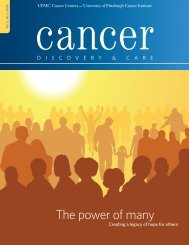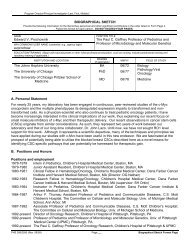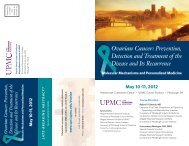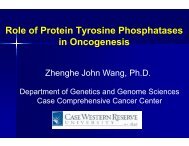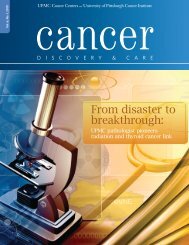D I S C O V E R Y & C A R E - University of Pittsburgh Cancer Institute
D I S C O V E R Y & C A R E - University of Pittsburgh Cancer Institute
D I S C O V E R Y & C A R E - University of Pittsburgh Cancer Institute
You also want an ePaper? Increase the reach of your titles
YUMPU automatically turns print PDFs into web optimized ePapers that Google loves.
4<br />
“You have to have a whole battery <strong>of</strong> techniques or<br />
technology at your disposal for hunting new viruses.<br />
”<br />
From the beginning, it seemed clear that KSHV caused cancer only<br />
when another factor — such as the AIDS virus, chronic malnutrition,<br />
immunosuppressive treatment, or advanced age — compromised the<br />
infected person’s immune system. In its evolution, Drs. Moore and<br />
Chang discovered that KSHV had stolen bits <strong>of</strong> the human genome<br />
— the DNA in our chromosomes — in order to subdue the body’s<br />
ability to fight it <strong>of</strong>f, and encourage the cells it infects to make new<br />
virus particles.<br />
These stolen genes read like a “Who’s Who” in cancer formation, running<br />
the gamut from genes that control cell division (necessary for viral<br />
growth) and programmed cell death (a defense against viral infection<br />
that the virus must turn <strong>of</strong>f) to genes that control the immune system’s<br />
response against viruses (again, necessary for the virus to turn <strong>of</strong>f).<br />
“Among viruses, KSHV has the most extensive repertoire <strong>of</strong> pirated<br />
genes that we know <strong>of</strong>,” says Dr. Moore. And when another factor,<br />
such as immune suppression, enters the picture, this fearsome array<br />
<strong>of</strong> counterfeit genes runs out <strong>of</strong> control: The same genes that helped<br />
the virus reproduce suddenly free the infected cell <strong>of</strong> the body’s<br />
controls over cell growth and movement — in other words, they<br />
make it cancerous.<br />
The researchers found that the genes stolen by KSHV hit the cell in<br />
pretty much the same places as previously discovered tumor viruses.<br />
UPMC <strong>Cancer</strong> Centers<br />
Among viruses, KSHV<br />
has the most extensive<br />
repertoire <strong>of</strong> pirated genes.<br />
But interestingly, the newcomer uses completely different genes to do it.<br />
In one fell swoop, the new virus identifies a batch <strong>of</strong> human genes that<br />
plays a major role in tumor development and tumor suppression.<br />
The virus also shows the researchers why different cancer viruses act<br />
differently. As Dr. Chang says, “We were all aware <strong>of</strong> the big splash<br />
made when the gene that causes cystic fibrosis was discovered.” In<br />
cancer, though, “… it’s not one specific gene; there are many genes<br />
that contribute. In addition, there are environmental factors.”<br />
The big question, Dr. Chang says, is whether all <strong>of</strong> these genes and<br />
factors are “created equal,” or some are more important for cancer<br />
formation. If the latter, those “master switches” would be particularly<br />
good targets for anticancer therapy. The relationship between KSHV<br />
and other tumor viruses suggests that the latter is true.<br />
“That explains why every virus affects the cell differently,” Dr. Chang adds.<br />
Casting a broad net<br />
Neither <strong>of</strong> the two scientists began their careers with a particular interest<br />
in tumor viruses or Kaposi’s sarcoma. Dr. Moore had been studying<br />
bacteria-caused meningitis epidemics in Africa; Dr. Chang had worked<br />
on the pathology <strong>of</strong> brain tumors and other brain diseases.<br />
But in 1993, the pair — he working for New York City’s public health<br />
department, she for Columbia <strong>University</strong> — read about a new virusdiscovery<br />
technology called representational difference analysis, or RDA.<br />
They began to wonder if the method might work to isolate the Kaposi’s<br />
virus, which researchers couldn’t find but believed existed, despite two<br />
decades <strong>of</strong> searching.<br />
Yuan Chang, MD<br />
Finding new viruses is a tough task even today, Dr. Chang observes:<br />
“We’re still only able to culture a small fraction <strong>of</strong> microbes out there.”<br />
RDA is both a subtle and brute-force method: You take a tiny<br />
amount <strong>of</strong> DNA from a Kaposi’s tumor, and a tiny amount from<br />
healthy tissue in the affected person. You match up the two and<br />
then expand the DNA sample using a process that only reproduces<br />
the sequences that are different. The different DNA, if any, is by<br />
definition alien to the host. So it must come from the virus.<br />
Drs. Moore and Chang still can’t believe their luck. The RDA<br />
process was a difficult, six-week procedure. But on the first try, it<br />
identified DNA fragments that belonged to KSHV, allowing them<br />
to isolate and sequence the rest <strong>of</strong> the virus.<br />
Still, Dr. Moore is philosophical about the way KSHV has driven<br />
their careers: “In science, you have to follow up the big questions<br />
that need to be answered, rather than just answering the questions<br />
you think you can.”<br />
Continuing the search<br />
Patrick S. Moore, MD, MPH<br />
As perhaps befits a research effort led by a married couple, their<br />
laboratory has a dual personality: half continuing to study KSHV<br />
in depth, and the other half using RDA and newer methods to<br />
discover more viruses.<br />
“You have to have a whole battery <strong>of</strong> techniques or technology at<br />
your disposal for hunting new viruses,” Dr. Chang says. This work<br />
is very much still in progress, but may teach more lessons about how<br />
viruses infect cells — and, thus, how those cells work. Subsequently,<br />
this teaches important lessons about how the infected cells misfunction<br />
in cancer.<br />
“There have been<br />
plenty <strong>of</strong> big breakthroughs<br />
… these<br />
breakthroughs need<br />
to be exploited.<br />
”<br />
The couple would also like to see their KSHV work pay <strong>of</strong>f in new<br />
cancer therapies.<br />
“There have been plenty <strong>of</strong> big breakthroughs in the field; I think<br />
these breakthroughs need to be exploited,” Dr. Moore says. “We’re<br />
at such an important stage in cancer virology. We have the entire<br />
human genome; in theory we know every gene. We can look<br />
at cells from various cancers in many, many different ways. But<br />
obviously, we haven’t found all the answers.”<br />
The support available at UPCI drew Drs. Moore and Chang to<br />
<strong>Pittsburgh</strong>. And it’s that environment that continues to drive<br />
their work. “UPCI has unique intellectual resources that can take<br />
advantage <strong>of</strong> the current state <strong>of</strong> science in cancer biology. But the<br />
comprehensive support — from administrators all the way down<br />
to donors — has been absolutely critical.” ■<br />
<strong>University</strong> <strong>of</strong> <strong>Pittsburgh</strong> <strong>Cancer</strong> <strong>Institute</strong><br />
5


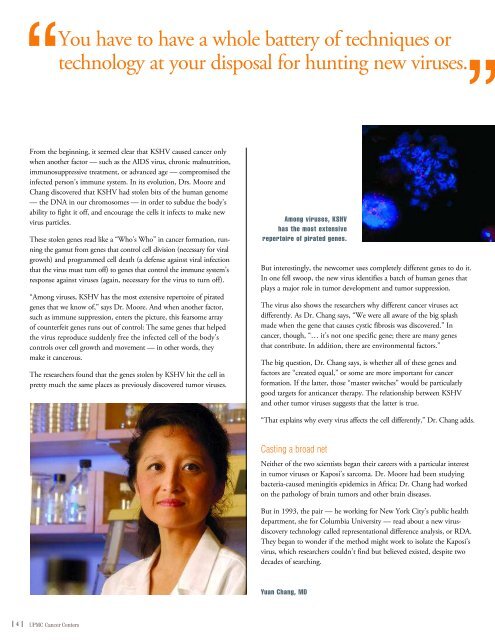
![Rodent Bedding technical info and Beddinig biblio[3] - University of ...](https://img.yumpu.com/51540189/1/190x245/rodent-bedding-technical-info-and-beddinig-biblio3-university-of-.jpg?quality=85)
